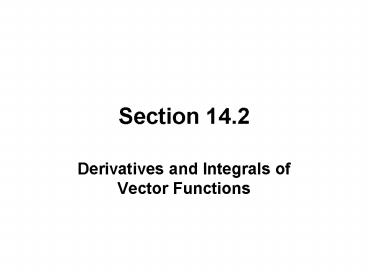Derivatives and Integrals of Vector Functions - PowerPoint PPT Presentation
1 / 8
Title:
Derivatives and Integrals of Vector Functions
Description:
Section 14.2 Derivatives and Integrals of Vector Functions THE DERIVATIVE OF VECTOR FUNCTION TANGENT VECTORS AND TANGENT LINES THEOREM SMOOTH CURVES DIFFERENTIATION ... – PowerPoint PPT presentation
Number of Views:461
Avg rating:3.0/5.0
Title: Derivatives and Integrals of Vector Functions
1
Section 14.2
- Derivatives and Integrals of Vector Functions
2
THE DERIVATIVE OF VECTOR FUNCTION
The derivative r'(t) of a vector function r is
defined to be provided the limit exists.
3
TANGENT VECTORS AND TANGENT LINES
- If r(t0) is the position vector for the point
P0(x0, y0, z0), then the vector r'(t0) is called
the tangent vector to the curve defined by r and
the point P0, provided that r(t0) exists and
r(t0) ? 0. - The tangent line to C at P0 is defined to be the
line through P0 parallel to the tangent vector
r(t0). - The unit tangent vector is defined to be
4
THEOREM
If
, where f, g, and h are
differentiable functions, then
5
SMOOTH CURVES
A curve given by a vector function r(t) on an
interval I is called smooth if r' is continuous
and r' ? 0 (except possibly at the endpoints of
I).
A curve is called piecewise smooth if it is made
up of a finite number of smooth pieces.
6
DIFFERENTIATION RULES
Suppose u and v are differentiable vector
functions, c is a scalar, and f is a real-valued
function. Then
(Chain Rule)
7
THE DEFINITE INTEGRAL
The definite integral of a continuous vector
function r(t) can be defined in the same way as
for real-valued functions. This will simplify to
8
THE FUNDAMENTAL THEOREM OF CALCULUS AND VECTOR
FUNCTIONS
Let R be an antiderivative of r, that is, R'(t)
r(t). Then
NOTE We use the notation ?r(t)dt for
indefinite integrals (antiderivatives).





























